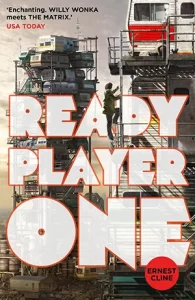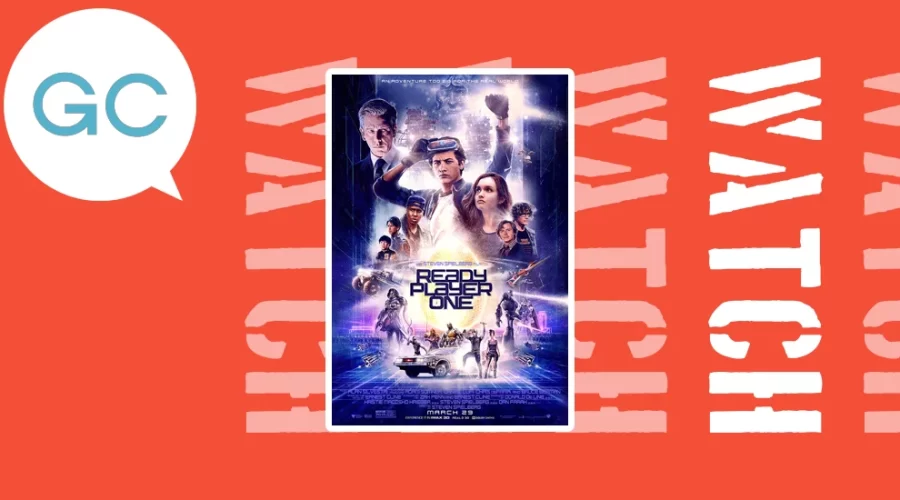It was the obvious choice for Great Adaptations in a month where sci-fi has been the focus over at Five Books For, my book recommendation newsletter.
More specifically, I’ve been thinking about books which might appeal to a wider audience than sci-fi enthusiasts. Ready Player One is lots of fun – not just for the pop culture references but for the sheer, exhilarating sense of adventure – even as it wrestles with weightier ideas.
But which version is better? Is the book’s geeky depth and celebration of 1980s pop culture more satisfying than the film’s broader, glossier dazzle?
Let’s press the start button and find out.
The book – nostalgia, adventure and nuance
 Ernest Cline’s 2011 novel is essentially a love letter to the 1980s, but underneath the Atari cartridges and Pink Floyd posters lies a surprisingly layered story about loneliness, longing, and identity.
Ernest Cline’s 2011 novel is essentially a love letter to the 1980s, but underneath the Atari cartridges and Pink Floyd posters lies a surprisingly layered story about loneliness, longing, and identity.
Our hero, Wade Watts, is a solitary teenager just about surviving in the ‘stacks’ (think of a trailer park where trailers have been stacked haphazardly on top of each other) of a dystopian future. His parents are dead, the aunt he lives with is awful, and his only escape is the OASIS, a vast virtual reality metaverse, co-created by tech giant James Halliday, who was obsessed with 1980s pop culture, video games, and of course programming.
Before he dies, Halliday creates a vast and elaborate Easter egg hunt within the OASIS, where the winner of the hunt will inherit both his fortune and control of Halliday’s company, which includes the OASIS itself.
A frenzy ensues when he dies and the hunt is announced, but after years pass without any progress, the hunt fades from the public consciousness, leaving only dedicated ‘gunters’ (egg hunters) still trying to solve the clues Halliday laid down in his will.
When Wade becomes the first person to crack the initial clue, he becomes a target of IOI, a sinister corporation determined to monetise the OASIS at any cost. Before long, Wade and his best friend Aech, and the allies they gather along the way, find themselves in a battle not just for the ideals of the OASIS, but also for their lives.
Can the plucky heroes defeat a huge corporation with almost-unlimited resources? Is there still hope for the world that Wade and his friends want to build, or has that moment already passed?
This is such a fun read – a rollicking adventure story wrapped in layers of pop culture references with energetic pacing and brilliant world-building.
If you lived through the 1980s, then this is even more joyous, but even readers unfamiliar with the references will feel the story’s exuberance leaping off the page.
This is such a fun read – a rollicking adventure story wrapped in layers of pop culture references with energetic pacing and brilliant world-building
The references range across music, TV and films, games, anime and more, with a distinct US bias. It works really well as a way to bring the reader into the story and makes the whole book feel like a big inside joke we’re all part of, even if you don’t catch every reference – and there are many.
The OASIS itself is a triumph of the imagination. I’m not a big fan of spending time online as a general rule but Cline makes the OASIS sound like huge fun; I totally got why it was so appealing to his characters, even without the dystopian reality they were living in being a factor.
Wade is an unlikely but enjoyable hero: initially immature and in some ways unprepossessing, he’s poor, awkward and driven by obsession, with a life that’s almost empty of human connection outside the OASIS.
As the book progresses, we see how he rises to every challenge he meets – I found myself rooting for him to win but also for his growth arc too.
Cline gives us deep access to Wade’s thoughts: his insecurities, his philosophical musings about technology and authenticity, his obsessive commitment to understanding Halliday, the enigmatic creator of the OASIS. The introspection grounds the cultural pastiche in something emotionally real and the love story is slow burning enough to feel realistic.
At the heart of the book is a treasure hunt, with riddles, puzzles, boss battles, and sabotage – just like Indiana Jones or The Goonies. The pacing is snappy, and as the escalating stakes move from the OASIS into the offline lives of the characters, I found myself hooked. I couldn’t wait to see what happened next.
Beneath the neon gloss, Ready Player One asks meaningful questions: what does it mean to live authentically in a world where fantasy is preferable to reality? How do we connect when we’re hiding behind avatars?
It also doesn’t shy away from showing how vulnerable virtual spaces and freedoms (like the surprisingly utopian original ideals of the internet) are to corporate greed and monopolisation.
Now that tech billionaires and their various schemes, corporate malfeasance and rivalries are constantly in the press, IOI has never been more chillingly believable as the villain of the piece.
If you love books which explore real issues in a fun, adventurous way, then this would be a great read. Ready Player One may have plenty of escapism and fun built in, but it’s a deceptively serious read.
The film – spectacle, action and shine
If you’re more in the market for a sensory extravaganza than an immersive adventure story, then the film might be a good pick. There’s tons of CGI, the pop-culture references are more visual and less 1980s-based, which means they’re more accessible, and everything generally just feels bigger and shinier.
There are some significant plot changes, and while I can see why they were made – presumably to create more set-piece action sequences and to simplify the egg hunt, which in the book is slow-moving and relatively complicated (although the narrative pacing means it never feels slow for the reader).
For me, the changes make the film a lot less fun.
That might be partly because I love a good puzzle, and the Easter egg hunt is significantly simpler in the film, but I think it’s fair to say that the film is enjoyable in a different way. It’s more accessible and kinetic than the book so while some of the emotional and intellectual depth has been sacrificed, the film is fun in a different way.
Had I known to expect the film to be so different I think I would have appreciated it more, so I hope the same proves true for you if you haven’t seen it already.
One of the things the film did less well for me was the characterisation. In the film, Wade is much less nuanced – more of an action hero. He doesn’t have anything near the arc he goes through in the book, and for that matter neither do any of the other characters. Aech is less present than in the book and the romance with Art3mis is reduced to something you might find in a romcom, whereas the love story in the book is much more convincing. Parzival’s declaration of love in the film comes almost out of nowhere, without much thought or consideration and it feels out of place because there hasn’t been any real build up to it, whereas in the book it feels like a natural part of the story.
The actual cast are great, but I feel like the script lets them down in this respect and the film really sacrifices some of the great things about the story for blockbuster adventure.
Ultimately the film is simpler and more accessible, employing lots of Hollywood panache – blockbuster pacing, huge action sequences, simplified emotional arcs – which also means it’s not as dark or as thoughtful as the book.
In this instance, I’d really recommend reading the book first, and then enjoying the film as a ‘loosely inspired by’ remix rather than a faithful adaptation – and if you do, there’s fun to be had. Just don’t expect it to level up in quite the same way

